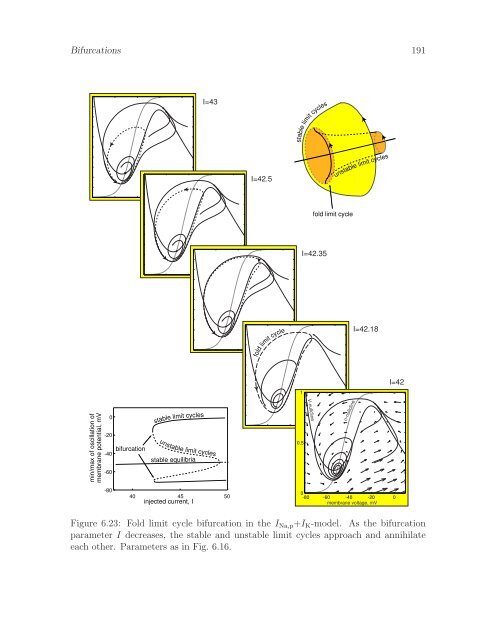Dynamical Systems in Neuroscience:
Dynamical Systems in Neuroscience: Dynamical Systems in Neuroscience:
190 Bifurcationsstableunstablelimit cyclelimitcyclefoldlimitcycleFigure 6.22: Fold limit cycle bifurcation: A stable and an unstable limit cycle approachand annihilate each other.bifurcation parameter approaches the bifurcation value I b .6.2.3 Fold limit cycleA stable limit cycle can appear (or disappear) via the fold limit cycle bifurcationdepicted in Fig. 6.22. Let us consider the figure from left to right, which corresponds tothe disappearance of the limit cycle, and hence to the disappearance of periodic spikingactivity. As the bifurcation parameter changes, the stable limit cycle is approached byan unstable one, they coalesce and annihilate each other. At the point of annihilation,there is a periodic orbit, but it is neither stable nor unstable. More precisely, it is stablefrom the side corresponding to the stable cycle (outside in Fig. 6.22), and unstable fromthe other side (inside in Fig. 6.22). This periodic orbit is referred to as being a fold(also known as a saddle-node) limit cycle, and it is analogous to the fold (saddle-node)equilibrium studied in Sect. 6.1. Considering Fig. 6.22 from right to left explains howa stable limit cycle can appear seemingly out of nowhere: As a bifurcation parameterchanges, a fold limit cycle appears, which then bifurcates into a stable limit cycle andan unstable one.Fold limit cycle bifurcation can occur in the I Na,p +I K -model having low-thresholdK + current, as we demonstrate in Fig. 6.23. The top phase portrait corresponding toI = 43 is the same as the one in Fig. 6.16. In that figure we studied how the equilibriumloses stability via subcritical Andronov-Hopf bifurcation, which occurs when anunstable limit cycle shrinks to a point. We never questioned where the unstable limitcycle came from. Neither were we concerned with the existence of a large-amplitudestable limit cycle corresponding to the periodic spiking state. In Fig. 6.23 we studythis problem. We decrease the bifurcation parameter I to see what happens with thelimit cycles. As I approaches the bifurcation value 42.18, the unstable and stable limitcycles approach and annihilate each other. When I is less than the bifurcation value,there are no periodic orbits, only one stable equilibrium corresponding to the restingstate.Notice that the fold limit cycle bifurcation explains how (un)stable limit cycles
Bifurcations 191I=43limitcyclesstableI=42.5unstable limitcyclesfold limit cycleI=42.35foldlimitcycleI=42.181I=42V-nullclinemin/max of oscillation ofmembrane potential, mV0-20-40-60bifurcationstablelimit cyclesunstable limit cyclesstable equilibria0.5n-nullcline-8040 45 50injected current, I0-80 -60 -40 -20 0membrane voltage, mVFigure 6.23: Fold limit cycle bifurcation in the I Na,p +I K -model. As the bifurcationparameter I decreases, the stable and unstable limit cycles approach and annihilateeach other. Parameters as in Fig. 6.16.
- Page 150 and 151: 140 Conductance-Based Modelsleak cu
- Page 152 and 153: 142 Conductance-Based Modelshyperpo
- Page 154 and 155: 144 Conductance-Based Models0I=0ina
- Page 156 and 157: 146 Conductance-Based Models0I=9.75
- Page 158 and 159: 148 Conductance-Based Models1I=651I
- Page 160 and 161: 150 Conductance-Based Modelshave co
- Page 162 and 163: 152 Conductance-Based Models1 sec10
- Page 164 and 165: 154 Conductance-Based Modelsvoltage
- Page 166 and 167: 156 Conductance-Based Models1h=0.89
- Page 168 and 169: 158 Conductance-Based Models5.2.2 E
- Page 170 and 171: 160 Conductance-Based Models1recove
- Page 172 and 173: 162 Conductance-Based Modelscurrent
- Page 174 and 175: 164 Conductance-Based Modelsmodels
- Page 176 and 177: 166 Conductance-Based Models
- Page 178 and 179: 168 Bifurcationssaddle-node bifurca
- Page 180 and 181: 170 Bifurcationssaddle-node bifurca
- Page 182 and 183: 172 Bifurcations0.5v 2V-nullclineK
- Page 184 and 185: 174 BifurcationsBoth types of the b
- Page 186 and 187: 176 BifurcationsV-nullcline0.5K + g
- Page 188 and 189: 178 Bifurcationsrstable limit cycle
- Page 190 and 191: 180 BifurcationsnVstable limit cycl
- Page 192 and 193: ¡ ¡¡ ¡¡ ¡ ¡¡ ¡ ¡182 Bifur
- Page 194 and 195: ¡ ¡ ¡¡ ¡ ¡¡ ¡ ¡¡ ¡ ¡184
- Page 196 and 197: 186 Bifurcationsmembrane potential,
- Page 198 and 199: 188 BifurcationsBifurcation of a li
- Page 202 and 203: 192 Bifurcationsamplitude (max-min)
- Page 204 and 205: 194 Bifurcationshomoclinic orbithom
- Page 206 and 207: 196 Bifurcations0.80.60.4stable lim
- Page 208 and 209: 198 Bifurcationsfrequency (Hz)40030
- Page 210 and 211: 200 BifurcationsSaddle-Focus Homocl
- Page 212 and 213: 202 Bifurcationsc 1c 2xFigure 6.34:
- Page 214 and 215: 204 BifurcationseigenvaluesHopffold
- Page 216 and 217: 206 Bifurcationsfast nullclineslow
- Page 218 and 219: 208 Bifurcationswith fast and slow
- Page 220 and 221: 210 BifurcationsSupercritical Andro
- Page 222 and 223: 212 BifurcationsK + conductance tim
- Page 224 and 225: 214 BifurcationsIn contrast, if the
- Page 226 and 227: 216 Bifurcationsinvariant circlesad
- Page 228 and 229: 218 Bifurcationsbifurcationssaddle-
- Page 230 and 231: 220 BifurcationsExercises1. (Transc
- Page 232 and 233: 222 Bifurcationsv 2v 11a-11-1Figure
- Page 234 and 235: 224 Bifurcations19. [M.S.] A leaky
- Page 236 and 237: 226 Excitabilityspike?spikerestrest
- Page 238 and 239: 228 ExcitabilityAlternatively, the
- Page 240 and 241: 230 Excitability50 ms 20 mV 1 ms100
- Page 242 and 243: 232 ExcitabilityClass 3 excitable n
- Page 244 and 245: 234 Excitability0.20.150.10.05I 1I
- Page 246 and 247: 236 Excitabilitysaddle-node bifurca
- Page 248 and 249: 238 Excitability(a) resting spiking
Bifurcations 191I=43limitcyclesstableI=42.5unstable limitcyclesfold limit cycleI=42.35foldlimitcycleI=42.181I=42V-nullcl<strong>in</strong>em<strong>in</strong>/max of oscillation ofmembrane potential, mV0-20-40-60bifurcationstablelimit cyclesunstable limit cyclesstable equilibria0.5n-nullcl<strong>in</strong>e-8040 45 50<strong>in</strong>jected current, I0-80 -60 -40 -20 0membrane voltage, mVFigure 6.23: Fold limit cycle bifurcation <strong>in</strong> the I Na,p +I K -model. As the bifurcationparameter I decreases, the stable and unstable limit cycles approach and annihilateeach other. Parameters as <strong>in</strong> Fig. 6.16.



